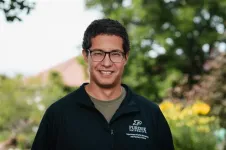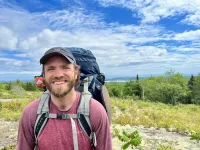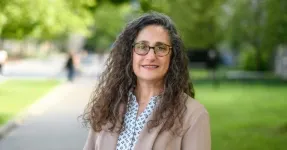(Press-News.org) WEST LAFAYETTE, Ind. — Across the Midwest during the warmer months, studying the sky for signs of storms and tornadoes becomes one of the most popular pastimes.
Dan Chavas, an associate professor in the Department of Earth, Atmospheric, and Planetary Sciences at Purdue University’s College of Science, takes it further: All day every day, he studies what makes tornadoes tick. Working at the intersection of climate science and meteorology, he looks at the big picture of what causes severe storms and tornadoes — and what dictates where they occur.
“I study both the climate and extreme weather,” Chavas says. “My research asks, ‘Why do we have severe thunderstorms or tornadoes at all?’ There are specific regions on Earth that have more storms, more tornadoes than other places. What creates these stormy regions?”
The central and eastern regions of the United States are among the top spots for severe thunderstorms and form the hot spot for the Earth’s most damaging and frequent tornadoes. Chavas uses real-world computer models to conduct experiments to determine what contributes to the formation of these storms.
“We have had these decades-old assumptions about what causes storms,” he says. “We’re validating those hypotheses and figuring out what makes North America such a hot spot.”
ADDITIONAL INFORMATION
Would we still have severe thunderstorms over North America if the Gulf of Mexico were filled in with land?
Cold winters don't mean there’s no global warming
Future hurricanes may cause havoc inland
Moving heaven and earth
Chavas isn’t a storm chaser. He’s not out there in a weather van topped with satellite wires hunting down individual storms for the insights they might yield. Nor can he grow storms in his lab or unleash tornadoes to understand their anatomy or behavior.
Instead, he harnesses decades of rich, detailed historical data and complex computer models to imagine and test what-if scenarios. He’s a storm tester.
“We use weather and climate models, as well as extensive databases of thunderstorms, lightning strikes, atmospheric data and more, to ask, ‘What if the world was different?’” Chavas says. “We can use these models as laboratories to ask questions like ‘What happens to the weather if you flatten the Rocky Mountains? What about if you fill in the Gulf of Mexico? What aspects of the modern continental and mountain configurations really matter? Let’s actually test this prevailing, conventional wisdom.’”
Both of those hypotheticals — flattening the Rockies and filling in the Gulf of Mexico — are the focus of studies Chavas and his team have conducted.
For more than 50 years, established wisdom said that the Gulf of Mexico, a source of warm, wet air flowing inland to the east of the Rocky Mountains, plays a major role in the formation of North America’s tornadoes. But no one knew for sure.
“It was a very reasonable hypothesis,” Chavas says. “There were a lot of very reasonable explanations. But no one had been able to test these 50-year-old ideas because they came about when there weren’t climate models with the necessary computational power. Now we can really start to understand the physics of the situation.”
When his team virtually filled in the Gulf of Mexico with land, they found that a dry Gulf of Mexico affected the frequency and severity of storms far less than they had expected. Without the Gulf of Mexico, severe thunderstorms shifted eastward from the central Great Plains into Illinois, although they were reduced over southern Texas.
“Severe thunderstorms and tornadoes form in environments with specific ingredients for how temperature, moisture, and especially wind speed and direction change with height in the atmosphere,” Chavas says. “The climate determines where and when those ingredients can be found together to produce these types of storms. Computer models let us understand why the ingredients are there in the first place and what role they each play in the weather we see.”
In his most recent study with graduate student Funing Li, just published in the Proceedings of the National Academy of Sciences, the team compared severe weather potential in North America, famous for tornadoes, with South America, which has a geography similar to North America’s and also many severe thunderstorms, but far fewer tornadoes. Their research has been funded by the National Science Foundation and NASA.
They found that the rough texture of the land surface east of the Andes mountains, its roughness determined in part by the hills and tall trees of the Amazon region, may play a large role in preventing tornadoes over central South America. In contrast, in North America many tornadoes form east of the Rockies, where air flows in from the much smoother ocean surface of the Gulf of Mexico. The team first used climate model experiments in which equatorial South America was smoothed to be similar to an ocean surface, which drastically increased central South America’s tornado potential. They also performed experiments in which the Gulf of Mexico region was roughened to be similar to a forested land surface, which strongly suppressed North American tornado potential.
“A rough surface upstream means that downstream the wind is no longer changing speed and direction with height very strongly near the surface, which we refer to as ‘wind shear,’” Chavas says. “It doesn’t change ingredients for severe thunderstorms, but the wind shear in the 1 kilometer of air above the ground is a critical ingredient for tornadoes.”
Storm warning
Real weather and real-world applications fascinate Chavas, a fascination born after a storm-torn tree fell on his house in Wisconsin when he was 4 years old.
The real-world implications of his research — what will the weather be like next week, next month, next year and next century — are what drives him.
“If we want to understand how climate change will affect weather in the future, we need to understand how climate determines weather in the first place,” Chavas says. “We don’t have a very good understanding of how climate controls the severe weather we have.”
Understanding how surface roughness and land use changes weather, for example, may enable future humans to better predict — and even partially affect — weather patterns. If the rough land of the Amazon, including a component from the trees of the Amazon, protects South America from tornadoes, could the regrowth of the United States’ eastern forests affect tornadoes, too?
Climate change affects the flow patterns of the atmosphere and moisture distribution on land, Chavas says.
“If we change the land surface and the trajectory of air flowing inland from the Gulf of Mexico, it may have a direct impact on these ingredients that give rise to tornadoes farther inland. When we think about climate change, we think about it getting hotter and the land getting drier. But if the jet stream changes where and how quickly air flows inland, it can change where and how tornadoes form. Places that didn’t see them before may see them more, and places that had more may see fewer,” he says. “We need to understand the weather now to help us better predict the weather of the future.”
About Purdue University
Purdue University is a public research institution demonstrating excellence at scale. Ranked among top 10 public universities and with two colleges in the top four in the United States, Purdue discovers and disseminates knowledge with a quality and at a scale second to none. More than 105,000 students study at Purdue across modalities and locations, including nearly 50,000 in person on the West Lafayette campus. Committed to affordability and accessibility, Purdue’s main campus has frozen tuition 13 years in a row. See how Purdue never stops in the persistent pursuit of the next giant leap — including its first comprehensive urban campus in Indianapolis, the Mitchell E. Daniels, Jr. School of Business, Purdue Computes and the One Health initiative — at https://www.purdue.edu/president/strategic-initiatives.
Writer/Media contact: Brittany Steff, bsteff@purdue.edu
Source: Dan Chavas, dchavas@purdue.edu
END
New twists on tornadoes: Earth scientist studies why U.S. has so many tornadoes
2024-06-27
ELSE PRESS RELEASES FROM THIS DATE:
Children’s Hospital of Philadelphia researchers find elementary age children experience more concussions during activities unrelated to sports
2024-06-27
Philadelphia, June 27, 2024 – Researchers from Children’s Hospital of Philadelphia (CHOP) found that young children between the ages of 5 and 12 were more likely to experience a concussion from recreation and other non-sport activities, yet those injuries were not seen by specialists until days later compared with sports-related concussions in the same age group.
This study suggests concussion research is needed for children outside of sports and that providing more resources and education ...
Ultrasounds may not find this cancer in Black women
2024-06-27
A common algorithm to check for endometrial cancer is not reliable for Black women, according to a new study published today in JAMA Oncology.
In Black patients with concerning symptoms, a tissue biopsy is strongly recommended to rule out endometrial cancer instead of using transvaginal ultrasound, the report concluded.
Endometrial cancer is the most common type of gynecological cancer in the United States. It is one of the few types of cancer now on the rise, especially among Black women, who are more likely to be diagnosed at later stages of the disease. This cancer can cause symptoms such as abnormal vaginal ...
Urban green and blue spaces are linked to less coronary artery calcification
2024-06-27
· Black participants with greater access to green spaces had up to 35% lower odds of calcification
· Black participants living near a river had 32% lower odds of calcification
· Coronary artery calcification is an early sign of cardiovascular disease
CHICAGO --- Being near and having more exposure to urban green space and blue (water) space is linked to lower odds of having coronary artery calcification in middle age, which is an early marker of cardiovascular disease.
The associations were more pronounced among Black individuals and those living in neighborhoods ...
US efforts to collect LGBTQ+ data among Medicaid patients is a ‘foundational step towards health equity'
2024-06-27
Compared to straight and cisgender individuals, sexual and gender minority adults in the US are more likely to face barriers paying for or accessing adequate health insurance and healthcare, but few states collect sexual and gender identity (SOGI) information to better understand the health challenges and needs of this population. To close this knowledge gap, the Centers for Medicare & Medicaid Services (CMS) added three optional SOGI questions to its model application, with guidance for states that choose to incorporate the questions into their Medicaid and Child Health Insurance ...
Wolves reintroduced to Isle Royale temporarily affect other carnivores, humans have influence as well
2024-06-27
MADISON–In a rare opportunity to study carnivores before and after wolves were reintroduced to their ranges, researchers from the University of Wisconsin–Madison found that the effects of wolves on Isle Royale have been only temporary. And even in the least-visited national park, humans had a more significant impact on carnivores’ lives.
The paper, published recently in Frontiers in Ecology and the Environment, uses DNA from foxes and martens’ scat and hair to understand where these animals were and what they ...
Common blood pressure drug may make leukemia more responsive to chemotherapy while protecting heart
2024-06-27
COLUMBIA, Mo. ― Researchers from the University of Missouri School of Medicine found that a targeted gene therapy may make acute myeloid leukemia (AML) more sensitive to chemotherapy, while also protecting the heart against toxicity often caused by cancer treatments.
Acute myeloid leukemia is the most common type of leukemia in adults and the resulting chemotherapy treatment can put patients at an increased risk for cardiac damage. Associate Professor of Medicine Dr. Xunlei Kang and PhD students Yi Pan and Chen Wang led a study looking at similarities between leukemia and cardiovascular disease. They found a shared target -- AGTR1, ...
High-speed internet linked to more farms offering agritourism
2024-06-27
UNIVERSITY PARK, Pa. — The availability and adoption of high-speed broadband appears to boost the number of farms offering agritourism activities, according to a new study led by Penn State researchers. Their findings, the researchers said, bolster the argument for expanding broadband availability in support of farm operators who want to benefit from the growing consumer interest in on-farm experiences.
“Agritourism operations are consumer-facing businesses that offer activities to farm or ranch visitors, such as farm stands, pumpkin patches, corn mazes, hayrides and ...
First of its kind study shines light on LGBTQ+ farmer mental health
2024-06-27
URBANA, Ill. -- LGBTQ+ people involved in farm work are over three times more likely to experience depression and suicidal intent and about two and a half times more likely to experience anxiety than the general population. That’s according to a new study led by farmer mental health experts at the University of Illinois Urbana-Champaign.
“For several years, I've done work around farm stress and mental health among farmers in general. We’ve found people who work in agriculture have adverse mental health compared to those who work in other areas. Similarly, there are findings that queer folks have worse mental health than their ...
Vaccination may reduce memory loss from COVID-19 infections
2024-06-27
Since the outset of the COVID-19 pandemic, 10 to 30 per cent of the general population has experienced some form of virus-induced cognitive impairment, including trouble concentrating, brain fog or memory loss. This led a team of researchers to explore the mechanism behind this phenomenon and pinpoint a specific protein that appears to be driving these cognitive changes.
A new study published in Nature Immunology, led by researchers at Western and Washington University School of Medicine in St. Louis, Missouri, also looked at how vaccination may help reduce the impacts of memory loss following COVID-19 infections.
The ...
Prenatal exposure to ethylene oxide associated with lower birth weight and head circumference in newborns
2024-06-27
A study led by the Barcelona Institute for Global Health (ISGlobal), a centre supported by the "la Caixa" Foundation, provides new evidence on the adverse effects of prenatal exposure to ethylene oxide (EO) on foetal development. The results, published in Epidemiology, show that increased EO exposure in utero is associated with a reduction in birth weight and head circumference in newborns.
Ethylene oxide is a chemical used in various industrial processes and in hospitals, is known for its ...



